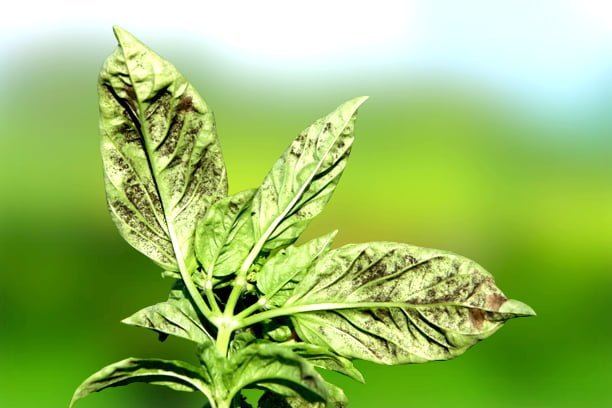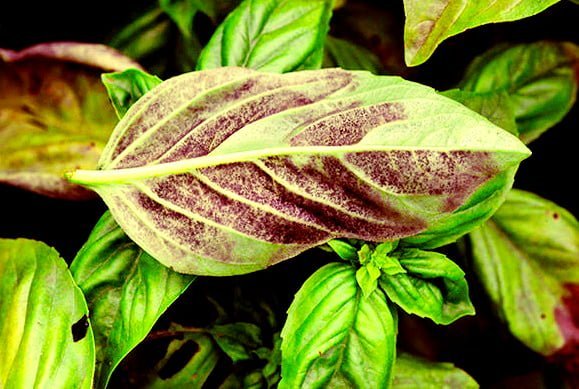Basil downy mildew is a fungal disease caused by the oomycete Peronospora belbahrii. It is most common in warm and humid climates and is characterized by white spots on the tops of the plant’s leaves. The disease can spread rapidly if not treated, and plant death can occur. To control this disease, fungicides and cultural management techniques can be used. Additionally, planting varieties of basil that have shown resistance to this disease can help minimize & the risk of infection.
What is Basil Downy Mildew?

The fungal disease known as Basil Downy Mildew is caused by the Peronospora belbahrii fungus. Basil plants are impacted by the occurrence of yellow spotting, necrotic tissue on the leaves, and shriveled flowers. If not properly addressed, this condition has the potential to impede growth or even result in the demise of a basil plant.
Basil Downy Mildew History and Origin
Peronospora belbahrii, commonly known as basil downy mildew, is a fungal pathogen that targets the Ocimum basilicum plant species, commonly referred to as basil. The first identification of the subject in question occurred in Italy in 1878, although its origin is thought to be from the Middle East. The identified pathogen exhibits a close relationship with the Plasmopara obducens species of potato downy mildew, which was first discovered in France during the early 1800s.
Since its initial discovery, the spread of Basil downy mildew has been rapid and it has been detected in the United States and other regions of Europe. The pathogen emerged as an epidemic in the eastern regions of the United States during the mid-1980s and has persisted as a concern in the mid-Atlantic region since the early 2000s. The presence of the aforementioned phenomenon has been confirmed in California, with its initial sighting dating back to 2006.
The proliferation of Basil downy mildew is attributed, in part, to its rapid development of resistance towards chemical fungicides. Therefore, the management of this pathogen in an agricultural setting necessitates the implementation of integrated management strategies, as chemical fungicides may not always be the optimal choice.
Symptoms of Disease
Basil downy mildew most commonly affects the leaves and stems of basil plants. Symptoms of an infestation include yellow patches or spots on the upper surfaces of leaves; white or grayish-purplish fuzz on the undersides of leaves; and leaves that curl, wither, and die. As the disease progresses, entire stems may become covered in white or grayish-purplish fuzz. Severe cases of downy mildew can lead to entire plant death.

Peronospora belbahrii Pathogen Biology
Basil Downy Mildew is a fungal disease caused by the pathogen Peronospora belbahrii. The disease is commonly seen in basil crops and can cause significant yield losses in a short amount of time. The pathogen can be spread through infested seeds, contaminated tools, and rain, among other ways. The pathogen creates dense, white, powdery colonies that appear on the underside of the leaves of infected basil plants. As the disease progresses, the leaves of the infected plant will start to yellow and curl up, eventually leading to premature plant death.
Control of downy mildew can be achieved through crop rotation and destruction of infected plant material. Prevention also plays a key role in controlling the spread of the disease, with correct spacing between plants, avoidance of overcrowding during planting, and use of disease-free seeds. Fungicides can also be used, but often become, less effective over time due to potential fungal resistance. Cultural practices such as removing plant debris, increasing sunlight and air circulation, and the use of clear plastic mulch can also be used to control the disease.
Lifecycle of Basil Downy Mildew Pathogen
- Infection: The downy mildew pathogen overwinters in soil and crop debris. Infection is initiated when spores, or sporangia, are splashed onto the leaf or stem surface where they may germinate within hours.
- Colonization: After germination, zoospores (motile single-celled organisms) are released from the spore and move to host tissue, where they puncture the stem and leaf cells. The zoospores may also form haustoria, or hanging bodies, within the cells to increase nutrient availability.
- Growth: Upon penetrating the leaf, zoospores form a protective structure called maintenance vellum. Here the pathogen begins to grow, causing the host tissue to die. Because the downy mildew pathogen requires moisture for sporulation, warm and wet weather is ideal for developing infection and spreading the pathogens.
- Production of Conidia: Finally, the pathogen begins to produce conidia (a type of spore), which are spread via wind and splashing of surface water to other plants or to environmental surfaces, such as soil and crop debris. These conidia are then available for infection of plants the following season.
Damage Symptoms
Basil downy mildew damage symptoms can appear suddenly and include yellowing and wilting of leaves, distorted shoots, stunted growth, and silver or gray fungal growth on the underside of leaves.
Downy Mildew Basil Treatment
- Plant-resistant varieties: Planting varieties that have some degree of resistance to basil downy mildew can help reduce the chances of the disease occurring.
- Crop rotation: Be sure to rotate the location of your basil crops in the garden so as not to encourage any build-up of disease pressure.
- Water early: You should water your basil plants early in the day so that the foliage can dry off before nightfall. This reduces the chances of any infection occurring.
- Space your plants: Allow a good distance between each plant when planting in the garden as this will give adequate air circulation.
- Remove infected plants: If any plants become infected, they should be immediately removed and destroyed to stop the disease spreading.
- Clean up debris: Remove any dead or diseased plants and leaves at the end of the season, as these can harbour fungal spores which might erupt again during the next season.
- Mulch: Mulching with organic matter helps regulate soil moisture levels, which in turn can reduce the chances of infection.
- Spray fungicides: If all else fails, spraying fungicides registered for use against basil downy mildew can help to contain the disease.
Chemical Control of Basil Downy Mildew
Apply preventive fungicide sprays to newly established plants and in the summer when high humidity favors disease development. These sprays may include dilute solutions of potassium bicarbonate-based products, horticultural oils, neem, and or treated sulfur. If symptoms are noticed, apply a fungicide to protect unaffected foliage. Use fungicides containing mancozeb, chlorothalonil, or copper-based compounds. Make applications every 7-14 days, depending on the product used. Follow the instructions closely and thoroughly cover all parts of the plant with the fungicide solution. Avoid overhead irrigation and water the plants at the soil level instead. This helps to limit the spread of the disease. Destroy all plant debris affected by the disease to help reduce spread.
Downy Mildew Basil Biological Control
Biological control of basil downy mildew can be achieved by introducing natural predators or parasitoids to the infected planting environment. Predators commonly used for basil downy mildew control include the predatory mite Phytoseiulus persimilis, which feeds on the fungus Oidium sp. or the fungus Stictococcus macrosporus. Other effective predators include the predatory thrips Amblyseius swirskii and the thrips-parasitizing nematode Steinernema carpocapsae. Parasitoids are also effective for downy mildew basil control. Common parasitoids used for basil downy mildew control include the tiny wasp, Encarsia formosa, and Ampelomyia clavate. These parasitoids target the fungus causing downy mildew basil directly, by feeding on it and reducing its severity. Additionally, as natural predators increase in number in the field. The population of the fungus causing basil downy mildew will decrease, allowing for a more sustainable approach to controlling downy mildew.
How To Prevent Downy Mildew on Basil
Preventing downy mildew basil requires a combination of good practices and, in some cases, the use of chemical remedies. Downy mildew is a fungal disease that can pose significant challenges for basil plants. Here are several recommended measures that can be implemented to mitigate the occurrence of downy mildew:
Optimal Lighting Conditions: Basil exhibits optimal growth in areas with ample exposure to direct sunlight. Ensure that your basil plants are exposed to a minimum of 6-8 hours of direct sunlight on a daily basis.
Water Management
- Avoid Overhead Watering: Water the soil, not the foliage, to prevent creating a moist environment that encourages fungal growth. Use a drip irrigation system or water at the base of the plant.
- Water in the Morning: Watering in the morning allows excess moisture on the leaves to dry before evening, reducing the risk of infection.
- Proper Soil Drainage: Ensure that the soil in your basil’s growing area has good drainage. Avoid waterlogged soil, which can contribute to the development of fungal diseases.
- Mulch: Apply mulch around the base of your basil plants to help maintain soil moisture and reduce the chances of soil splashing onto the leaves.
- Pruning and Air Circulation: Regularly prune basil to encourage air circulation through the plant. Remove any damaged or infected leaves as soon as you notice them.
- Fertilize Appropriately: Avoid over-fertilizing basil, as excessive nitrogen can make it more susceptible to downy mildew. It is recommended to utilize a balanced, slow-release fertilizer.
Natural Remedies
Neem oil is a natural fungicide that can help control downy mildew. Mix it with water according to the instructions on the product label and spray it on your basil plants. A mixture of water and baking soda can be sprayed on basil leaves to help prevent fungal infections. Use 1 tablespoon of baking soda per gallon of water. If downy mildew becomes a severe problem, you may need to use a fungicide specifically designed to control it. Follow the product label instructions carefully when using fungicides.
Basil Fungicide
Basil is susceptible to various fungal diseases, and the term “basil fungicide” refers to a substance or product that is used to prevent or treat fungal infections in basil plants. Fungal diseases that commonly affect basil include:
Downy Mildew (Peronospora belbahrii): This is a common fungal disease in basil, and it can cause yellowing and wilting of leaves. To prevent and manage downy mildew, you can use fungicides that contain active ingredients like copper-based compounds or biofungicides based on beneficial microorganisms.
Fusarium Wilt (Fusarium oxysporum): Fusarium wilt can lead to yellowing and wilting of basil plants. Fungicides that contain active ingredients like potassium phosphite may help in managing this disease.
Botrytis Rot (Botrytis cinerea): This fungus can cause gray mold on basil leaves and stems. Fungicides with active ingredients like myclobutanil or other broad-spectrum fungicides can be used to control botrytis rot.
When using fungicides on basil, it’s essential to follow the manufacturer’s instructions and guidelines carefully. Additionally, consider using organic or natural fungicides if you prefer a more environmentally friendly approach to managing fungal diseases in your basil plants. Proper plant care practices, such as providing good air circulation, avoiding overhead watering, and maintaining healthy soil conditions, can also help reduce the risk of fungal diseases in basil.

